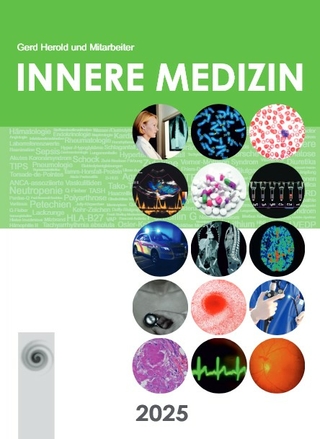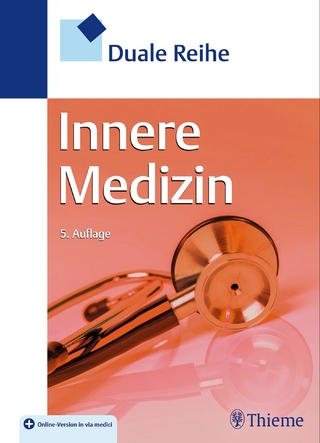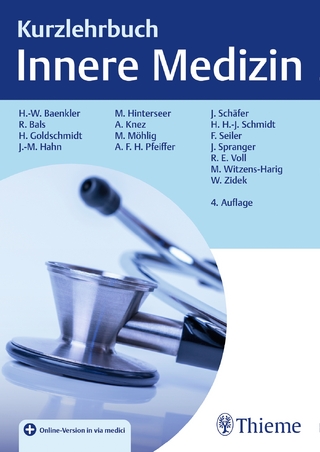
Harrison's Principles of Internal Medicine
McGraw-Hill Professional (Verlag)
978-0-07-180215-4 (ISBN)
- Titel ist leider vergriffen;
keine Neuauflage - Artikel merken
Through six decades, no resource has matched the encyclopedic scope, esteemed scholarship, and scientific rigor of Harrison's Principles of Internal Medicine. Both an educational tool and a clinical reference, it remains one of the most widely read and universally respected textbooks in all of medical publishing and the pinnacle of current medical knowledge.
The Nineteenth Edition of Harrison's features a new slimmer presentation, logically divided into two volumes. Volume 1 covers essential foundational-level material on the basic principles underlying optimal patient care and assessment of signs and symptoms. Volume 2 is devoted to specific diseases and the best evidence based approaches to their management.
Capturing the countless advances and developments across the full span of medicine, this edition of Harrison's offers a complete update of all content related to pathophysiology and pathophysiology, clinical trials, evidence-based practice guidelines, current diagnostic methods, and established and new treatment methods. NEW chapters on important topics such as Men's Health, Fatigue, Management of Heart Failure, Infertility, and Contraception Increased number of clinical decision trees, radiographic examples, clinical images, tables and summary lists Presented in two volumes:
- Volume 1 is devoted to cardinal manifestations of disease and approach to differential diagnosis
- Volume 2 covers specific diseases and disorders
The Harrison’s DVD has been expanded to include 137 e-chapters. They provide deeper insight into essential medical education and clinical medical topics, in addition to offering these other outstanding features:
- More than 153 videos with step-by-step procedures performed at the bedside
- Hundreds of additional images from imaging and clinical pathology
- New videos covering important topics, such as sleep disorders, tissue engineering, and noninvasive cardiac imaging
137 additional chapters and more than 500 images make the companion DVD an essential part of every physician's education, practice, and lifelong learning.
This companion DVD is an essential part of every physician’s education, practice, and lifelong learning.
The DVD also allows you to preview two indispensable online medical resources FREE AccessMedicine, featuring Harrison’s Online, and ClinicalAccess Essentials — targeted answers to 120,000 clinical questions.
Dennis Kasper, MD is Professor of Medicine at Harvard and a leading researcher of the health and disease implications related to the human microbiome.
Anthony Fauci, MD is Director of the National Institutes for Allergy and Infectious Diseases, and recipient of the 2007 Lasker Prize for Medicine along with many other awards too numerous to mention. He is the chief federal official responsible for policy in AIDS and HIV research and public health, as well as bioterrorism response.
Dan Longo, MD has been a Harrison's editor for three editions, and is Professor of Medicine, Brigham and Women's Hospital/Harvard Medical School. Dr. Longo is a cancer specialist.
Stephen Hauser MD is Chair of Neurology at UCSF and editor of Archives of Neurology.
J. Larry Jameson, MD, PhD is Executive Dean of the University of Pennsylvania Health System.
Joseph Loscalzo MD, PhD is Hersey Professor of the Theory and Practice of Medicine, Harvard Medicine School. He is editor-in-chief of the leading journal in cardiology, Circulation.
Part 1 General Considerations in Clinical Medicine
Part 2 Cardinal Manifestations and Presentation of Diseases
Section 1 Pain
Section 2 Alterations in Body Temperature
Section 3 Nervous System Dysfunction
Section 4 Disorders of Eyes, Ears, Nose, and Throat
Section 5 Alterations in Circulatory and Respiratory Functions
Section 6 Alterations in Gastrointestinal Function
Section 7 Alterations in Renal and Urinary Tract Function
Section 8 Alterations in Sexual Function and Reproduction
Section 9 Alterations in the Skin
Section 10 Hematologic Alterations
Part 3 Genes, the Environment, and Disease
Part 4 Regenerative Medicine
Part 5 Aging
Part 6 Nutrition and Weight Loss
Part 7 Oncology and Hematology
Section 1 Neoplastic Disorders
Section 2 Hematopoietic Disorders
Section 3 Disorders of Hemostasis
Part 8 Infectious Diseases
Section 1 Basic Considerations in Infectious Diseases
Section 2 Clinical Syndromes: Community-Acquired Infections
Section 3 Clinical Syndromes: Health Care–associated Infections
Section 4 Approach to Therapy for Bacterial Diseases
Section 5 Diseases Caused By Gram-Positive Bacteria
Section 6 Diseases Caused By Gram-negative Bacteria
Section 7 Miscellaneous Bacterial Infections
Section 8 Mycobacterial Diseases
Section 9 Spirochetal Diseases
Section 10 Diseases Caused By Rickettsiae, Mycoplasmas, and Chlamydiae
Section 11 Viral Diseases: General Considerations
Section 12 Infections Due to DNA Viruses
Section 13 Infections Due to DNA and RNA Respiratory Viruses
Section 14 Infections Due to Human Immunodeficiency Virus and other Human Retroviruses
Section 15 Infections Due to RNA Viruses
Section 16 Fungal Infections
Section 17 Protozoal and Helminthic Infections: General Considerations
Section 18 Protozoal Infections
Section 19 Helminthic Infections
Part 9 Terrorism and Clinical Medicine
Part 10 Disorders of the Cardiovascular System
Section 1 Introduction to CardiovasCular Disorders
Section 2 Diagnosis of Cardiovascular Disorders
Section 3 Disorders of Rhythm
Section 4 Disorders of the Heart
Section 5 Coronary and Peripheral Vascular Disease
Part 11 Disorders of the Respiratory System
Section 1 Diagnosis of Respiratory Disorders
Section 2 Diseases of the Respiratory System
Part 12 Critical Care Medicine
Section 1 Respiratory Critical Care
Section 2 Shock and Cardiac Arrest
Section 3 Neurologic Critical Care
Section 4 Oncologic Emergencies
Part 13 Disorders of the Kidney and Urinary Tract
Part 14 Disorders of the Gastrointestinal System
Section 1 Disorders of the Alimentary Tract
Section 2 Liver and Biliary Tract Disease
Section 3 Disorders of the Pancreas
Part 15 Immune-Mediated, inflammatory, and Rheumatologic Disorders
Section 1 The Immune System in Health and Disease
Section 2 Disorders of Immune-Mediated Injury
Section 3 Disorders of the Joints and Adjacent Tissues
Part 16 Endocrinology and Metabolism
Section 1 Endocrinology
Section 2 Reproductive Endocrinology
Section 3 Obesity, Diabetes Mellitus, and Metabolic Syndrome
Section 4 Disorders of Bone and Mineral Metabolism
Section 5 Disorders of Intermediary Metabolism
Part 17 Neurologic Disorders
Section 1 Diagnosis of Neurologic Disorders
Section 2 Diseases of the Central Nervous System
Section 3 Nerve and Muscle Disorders
Section 4 Chronic Fatigue Syndrome
Section 5 Psychiatric and Addiction Disorders
Part 18 Poisoning, Drug Overdose, and Envenomation
Part 19 Disorders Associated with Environmental Exposures
The Editors are pleased to present the 19th edition of Harrison’s Principles of Internal Medicine. Since the first edition was published 65 years ago, virtually every area of medicine and medical education has evolved remarkably, and many new fields have emerged. While retaining the founding goals of Harrison’s, this edition has been modified extensively in light of the varied needs of the book’s readers and the diverse methods and formats by which information is now acquired and applied. The focus of medical education worldwide is shifting from the classic structure/function/disease approach to an integrated, often case-based approach in which basic and population sciences are specifically linked to the practical diagnosis and management of disease. Many of the updates and changes described here have been undertaken with the modern educational and clinical environments in mind. This new edition offers a thoroughly updated presentation of the classic pathophysiologic basis of clinical medicine and details the cutting-edge methods and tools that are now available for the assessment of symptoms and the effective management of diseases in the modern patient-care environment. The text is supplemented by germane new photographs, radiographs, illustrations, atlases, patient-care algorithms, tables, and practical demonstrative videos. In the interest of producing the most practical format possible for the 19th edition, a new system of referencing has been used. Detailed bibliographic listings, with summaries of articles’ relevance to practice, appear in the online edition, replacing the general and limited collection of Suggested Readings that appeared in the prior print editions. The 19th edition of Harrison’s is designed for accessibility and flexibility. The print textbook is available in two volumes. Volume 1 focuses on the foundations of medicine and the understanding and assessment of cardinal disease manifestations; Volume 2 focuses on specific diseases, by system. This functional division will be helpful to students who are mastering the basis of clinical medicine and to clinicians who are more focused on gaining an advanced understanding of mechanisms and patient care in specific diseases. In terms of digital media, Harrison’s is now available as an eBook on multiple platforms, as an enhanced “app” developed especially for tablet and smartphone devices that offer high-definition resolution of multimedia content and interactive features, and as an updated online edition. All of these options provide access to our numerous e-chapters as well as to videos and atlases. Additional resources include the Harrison’s Self-Assessment and Board Review, a useful study guide based on information in the 19th edition, and the Harrison’s Manual of Medicine, a pocket version of Harrison’s Principles of Internal Medicine. A new Harrison’s collection of case vignettes emphasizing differential diagnostic considerations in the assessment of cardinal manifestations will also be available. Advances in medical science have been spectacular since Harrison’s was first published in 1949. At that time, peptic ulcer disease was thought to be caused by stress, nearly every tumor that was not resected resulted in death, rheumatic heart disease was widely prevalent, and hepatitis B and HIV infection were unknown. In the intervening years, both the infectious cause of and the cure for peptic ulcer disease were identified; advances in diagnosis and treatment made it possible to cure two-thirds of cancers; rheumatic heart disease virtually disappeared; atherosclerotic coronary artery disease waxed and then—at least in part through management of modifiable risk factors—began to wane; hepatitis B and its consequences, cirrhosis and hepatocellular carcinoma, became preventable by a vaccine; and HIV, first viewed as a uniformly fatal worldwide scourge, became a treatable chronic disease. Notably, emerging and reemerging diseases have presented significant challenges to medical research and practice, while a new understanding of systems-wide concepts such as the microbiome offers exciting new possibilities for understanding and managing health and disease in ways never before possible. Of particular note in this 19th edition are critical updates in the classic chapter on HIV/AIDS, which offers both a clinically pragmatic focus and a comprehensive and analytical approach to pathogenesis. The updates cover the latest treatment protocols and address the issue of combination prevention modalities, making the chapter the most up-to-date and comprehensive treatise on HIV disease available. Several other chapters likewise reflect the rapid pace of advancement in the field of immune-related diseases and their treatment. In this regard, Chapter 372e, “Introduction to the Immune System,” serves as a mini-textbook of immunology for use in immunology courses. In addition, a new chapter on IgG4-mediated disease summarizes an important and newly recognized constellation of entities. Readers will find expanded coverage of the neurodegenerative diseases, highlighting advances in their classification and management and delineating the new understanding of mechanisms responsible for the deposition and spread of pathogenic protein aggregates in these disorders. The chapter on chronic hepatitis discusses in detail the dramatic new discoveries in the use of direct-acting antiviral agents for the treatment of hepatitis C virus disease; these agents are responsible for some of the most exciting therapeutic advances in medicine today. The rapidly expanding application of genetic knowledge to medicine is covered in many chapters, including a new chapter on microbial genomics and infectious diseases and substantially updated chapters on the human microbiome and chromosomal genetic disorders. Other new chapters address timely topics such as the impact of climate change on disease, infections in U.S. veterans returning from foreign wars, and advances in contraception and the treatment of infertility. Another topic of increasing interest, the impact of aging on health and disease, is addressed by several chapters, including a newly authored chapter on the biology of aging. A new chapter on men’s health complements the updated chapter on women’s health. New chapters also address diverse topics including the emerging field of tissue engineering, the examination of the comatose patient, the management of heart failure, the major characteristics of helminths and helminthic infections, specific cardiac valvular disorders, venous and lymphatic diseases of the extremities, renovascular disease, late complications of diabetes, chronic myeloid leukemia, heat-related illnesses, fatigue, polyglandular failure syndromes, and nonalcoholic fatty liver disease and nonalcoholic steatohepatitis. Supplementing new content and updates on diseases and patient care, new videos in this edition cover sleep disorders, tissue engineering, noninvasive cardiac imaging, examination of the comatose patient, and myasthenia gravis and other diseases of the neuromuscular junction. New atlases for this edition address noninvasive imaging, percutaneous revascularization, and gastrointestinal endoscopy. We have many people to thank for their efforts in producing this book. First, the authors have done a superb job of producing authoritative chapters that synthesize vast amounts of scientific and clinical data to create state-of-the-art descriptions of medical disorders encompassed by internal medicine. In today’s information-rich, rapidly evolving environment, they have ensured that this information is current. Helpful suggestions and critical input have been provided by a number of colleagues; particularly notable was the advice of Chung Owyang on the Gastroenterology Section. We are most grateful to our colleagues in each of our editorial offices who have kept track of the work in its various phases and facilitated communication with the authors, with the McGraw-Hill Education staff, and among the editors: Patricia Conrad, Patricia L. Duffey, Gregory K. Folkers, Julie B. McCoy, Elizabeth Robbins, Anita Rodriguez, and Stephanie Tribuna. The staff at McGraw-Hill Education has been a constant source of support and expertise. James Shanahan, Associate Publisher for McGraw-Hill Education’s Professional Publishing Division, has been a superb and insightful partner to the editors, guiding the development of the book and its related products in new formats. Kim Davis, as Associate Managing Editor, has adeptly ensured that the complex production of this multi-authored textbook proceeded smoothly and efficiently. Dominik Pucek oversaw the production of the new procedural videos. Jeffrey Herzich ably served as production manager for this new edition. We are privileged to have compiled this 19th edition and are enthusiastic about all that it offers our readers. We learned much in the process of editing Harrison’s and hope that you will find this edition a uniquely valuable educational resource. The Editors
| Erscheint lt. Verlag | 16.5.2015 |
|---|---|
| Reihe/Serie | Internal Medicine |
| Sprache | englisch |
| Gewicht | 4926 g |
| Einbandart | gebunden |
| Themenwelt | Medizin / Pharmazie ► Medizinische Fachgebiete ► Innere Medizin |
| Studium ► 2. Studienabschnitt (Klinik) ► Innere Medizin / EKG | |
| Schlagworte | Clinics: Internal Medicine • Harrison • Harrisons Manual of Medicine • Harrisson • Innere Medizin Standardwerk • Internal Medicine • Internal medicine diseases • principles and practice • Studium Humanmedizin: 2. Studienabschnitt Innere Medizin |
| ISBN-10 | 0-07-180215-0 / 0071802150 |
| ISBN-13 | 978-0-07-180215-4 / 9780071802154 |
| Zustand | Neuware |
| Informationen gemäß Produktsicherheitsverordnung (GPSR) | |
| Haben Sie eine Frage zum Produkt? |
aus dem Bereich



